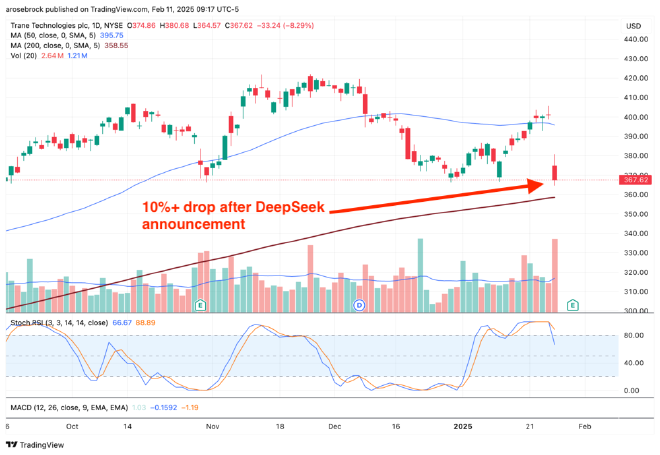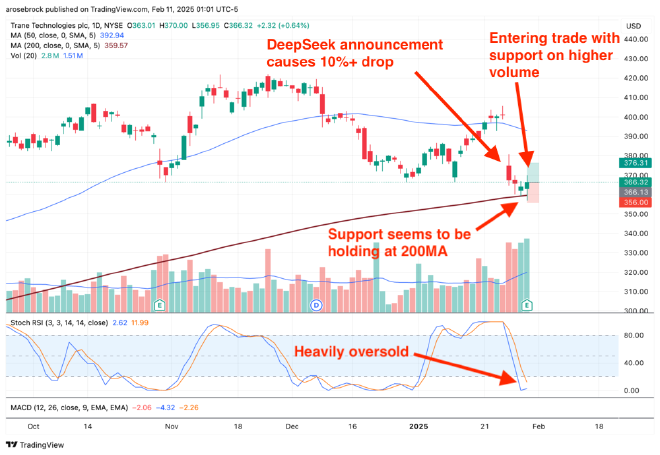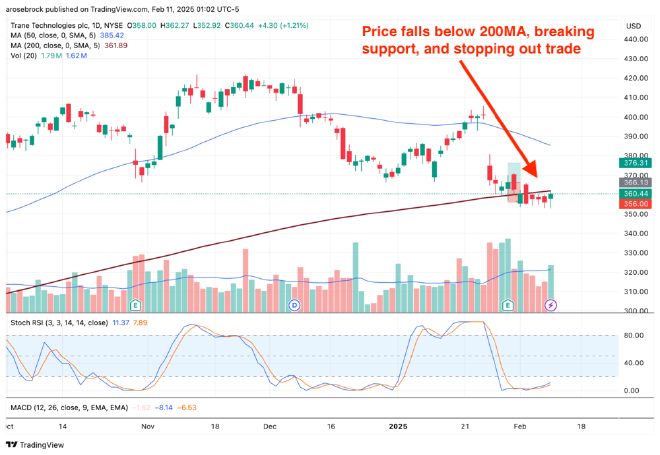The problem with buying the dip (don't try to catch a falling knife)

Table of Contents
Last week, I managed to turn a perfectly good trading strategy into an expensive lesson in humility, courtesy of Trane Technologies (TT).
And since my therapist says sharing is healing, let’s break down how I managed to ignore my trading plan and had to get a few stitches after trying to “catch a falling knife.”
DeepSeek creates market volatility, leads to potential setup for TT #
The catalyst for this adventure in poor decision-making was DeepSeek’s announcement, which created massive self-offs in technology and adjacent sectors.
The market, in its infinite wisdom (and occasional panic), decided that anything remotely connected to data center cooling needed a 10% haircut.
Why, you may wonder?
Because DeepSeek’s new LLM promised to make AI training more efficient and cheaper, potentially reducing the need for massive data center cooling systems.
I had just come off a successful trade with CLS, hitting 3R in under 24 hours, and was feeling pretty good about my ability to spot oversold opportunities.
As they say, “pride comes before the fall.”
What does Trane Technologies (TT) do? #

Before I walk you through my expensive lesson in patience, let’s talk about what TT actually does.
Trane Technologies is a global climate innovator that specializes in heating, ventilation, and air conditioning (HVAC) systems.
Think of them as the company that keeps your servers from melting and your data centers from turning into expensive saunas.
The 10% drop that caught my eye #

When DeepSeek dropped their announcement, both TT and its competitor Lennox International (LII) took a nosedive of more than 10%.
The truly fascinating part?
Lennox had just reported exceptional quarterly earnings and that beat projections, with Trane expected to release their quarterly reports to similar high expectations later in the week.
But the market was too busy panic-selling to notice the fundamentals.
Here’s where I made my first mistake:
I saw this as another CLS situation — an overreaction waiting to be corrected.
And technically, I still believe I’m right about that part. I don’t believe the problem with the analysis; it was with my timing and execution (which, honestly, is the most important part).
The market’s fear made sense on paper — if DeepSeek’s LLMs makes AI training more efficient and cheaper, data centers might need less cooling.
But sometimes the market’s short-term reaction and long-term reality don’t quite match up (hence, opportunities for swing traders).
Entering the TT trade #

Here’s a breakdown of my entry:
- Monday, January 27th: TT dropped over 10% on DeepSeek’s announcement, finding tentative support at the daily 200MA.
- Tuesday-Wednesday: Price held above the 200MA, while Stochastic RSI showed extreme oversold conditions.
- Thursday: TT reported strong earnings, beating expectations on both revenue and profit. I entered the trade that day with a stop loss just below the 200MA.
Additionally, TT’s weekly 40MA provided additional confluence as a potential support:

“Surely,” I thought to myself (always a dangerous start to any trading decision), “this is the bottom.”
I entered the trade on Thursday, setting my stop loss just below the 200MA (because that’s what responsible traders do when they’re about to make an irresponsible decision).
Stopped out of trade 48 hours later #

But the market didn’t care about my thesis. The price broke below the 200MA, failed to reclaim it, and continued to fall.
My stop loss was hit within 48 hours.
Annoyed with myself for opening a position outside of my trading style #
My usual trading style is pretty straightforward:
- Identify top stocks outperforming S&P 500 and relevant sector benchmarks
- Trade off the daily 50MA
- Look for oversold conditions via Stochastics RSI
- Wait for high volume support on top of daily 50MA
- Enter trade with a stop loss within 2.5-5% of the 50MA
Instead, what did I do?
I saw a stock that was:
- ✅ Oversold
- ✅ Top performer
- ✅ Solid fundamentals
- ✅ Just reported strong quarterly earnings and revenue
- ❌ Was nowhere near my preferred setup (oops)
“This time it will be different”, I thought to myself.
(Narrator: It wasn’t)
Final thoughts #
I know better than to try to catch a falling knife. I failed to protect my capital.
Next time, I’ll wait for the fat pitch — the clean, high-probability trade that aligns with my strategy.
Patience pays. Chasing doesn’t.
The falling knife left a mark, but at least I still have all my fingers.
Disclaimer: This is my trading journal, not your personal investment guide. Think of it like watching someone's cooking show — just because I'm making pad thai doesn't mean you should too (especially if you're allergic to peanuts). Sometimes I hold positions in the stocks I write about (shocking, I know). But that doesn't mean you should copy my trades and YOLO your life savings. Do your own research, consult actual professionals, and never trade more than you can afford to lose.